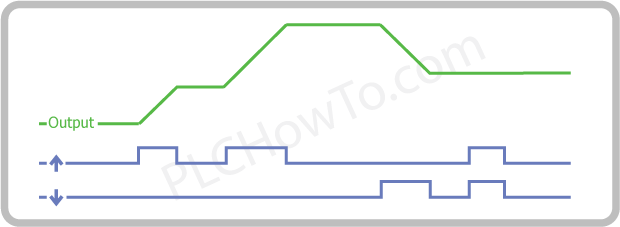![]()
 A Ramp brings a Output value up or down at a set rate.
A Ramp brings a Output value up or down at a set rate.
Data Used in Simple Ramp:
- Output that will be raised or lowered (Integer or Float)
- Acceleration/Deceleration Rate (Integer or Float).  Typically measured in Units/Sec²
- Acceleration Input
- Deceleration Input

In this example we see that:
- Output Rises when Acceleration Input (Up Arrow) is high
- Output Lowers when Deceleration Input (Down Arrow) is high
- Output remains steady nothing when both Acceleration and Deceleration Input are low or high.
- Though not obvious in this example, Acceleration/Deceleration Rate controls the steepness of the rise & fall in output value.
Now lets look at a more sophisticated Ramp. ¬†We’ll add the following options:
- Maximum & Minimum  (Integer or Float)
- Soft Start Time (Integer or Float) typically measured in ms.  This is the time taken to transition from steady state to Acceleration/Deceleration Rate.  This can reduce the stress on motors.
 In this example we see:
In this example we see:- Once the Maximum is reached, the Output quits Rising, even when the Acceleration Input is High.  Similar behavior would occur for Minimum if it were included in the example.
- Including Soft Start Time lengthens the amount of time it takes to reach a value.

                                                                       
                                                                      
Leave a Reply